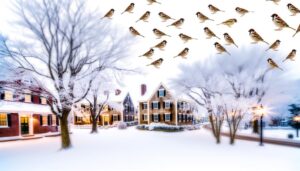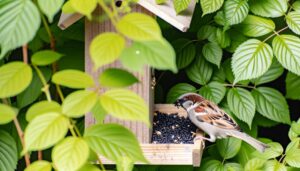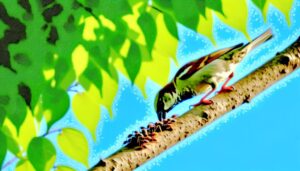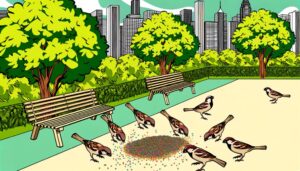10 Key Differences Between Female House Finch Vs Sparrow
Female House Finches and Sparrows can be differentiated through various characteristics. House Finches have uniform brownish streaking, a slightly curved bill, and a longer, slender body of 13-14 cm.
In contrast, Sparrows exhibit varied brown and gray coloration, a short, conical bill, and a stockier body. Finch plumage is more evenly streaked, whereas Sparrows exhibit bold, irregular streaking and prominent eye stripes.
Their habitats also differ; House Finches prefer urban areas and nest in man-made structures, while Sparrows adapt to diverse environments, often nesting in dense shrubbery. For those intrigued by avian diversity, these distinctions are just the beginning.

Key Takeaways
- Female House Finches have uniform brownish streaking, while female Sparrows show varied brown and gray coloration.
- House Finches possess slightly curved bills, whereas Sparrows have shorter, conical bills.
- Female House Finches have evenly distributed brown streaks, contrasting with the bolder, irregular streaking of female Sparrows.
- House Finches prefer urban settings and use twigs and feathers for nests; Sparrows favor diverse environments and use grass and paper scraps.
- House Finches are social in foraging, while Sparrows are more territorial and defend their foraging areas vocally.
Physical Appearance
The physical appearance of female House Finches (Haemorhous mexicanus) and female Sparrows (Passeridae family) can be distinguished by careful observation of their plumage, size, and distinct markings.
Female House Finches generally exhibit a more uniform brownish streaking across their bodies, with a slightly curved bill that is adapted for seed consumption.
In contrast, female Sparrows typically display a more varied brown and gray coloration, often with a distinct eye stripe and more pronounced streaking on the back and flanks. Additionally, Sparrows tend to have a stockier build and a shorter, conical bill suited for cracking seeds.
These morphological differences are subtle but critical for accurate identification, especially in habitats where both species coexist.
Plumage Patterns
When comparing plumage patterns, female House Finches exhibit a more uniform and less contrasting streaking across their bodies, whereas female Sparrows display a greater variety of markings, including prominent eye stripes and varied streaking on their flanks and back.
The House Finch's plumage consists of fine, evenly distributed brown streaks, creating a more monotonous appearance overall.
In contrast, female Sparrows possess distinct features such as the supercilium, a light-colored stripe running above the eyes, which enhances their facial contrast. Additionally, the streaking on a Sparrow's body tends to be bolder and more irregular.
These differences in plumage patterns are critical for species identification and understanding the ecological adaptations of each bird within their respective habitats.
Size and Shape
In comparing the size and shape of female House Finches and Sparrows, notable distinctions emerge. The body length of the female House Finch typically ranges from 13 to 14 cm, slightly exceeding that of the average Sparrow, which measures approximately 12 to 14 cm.
Additionally, the House Finch exhibits a more conical beak shape, optimized for seed consumption, contrasting with the Sparrow's shorter, stouter beak, suited for a varied diet, while tail length variations further differentiate these species.
Body Length Comparison
House Finches typically exhibit a more elongated body shape compared to the relatively stouter form of Sparrows. Female House Finches generally measure between 5 to 6 inches in length, whereas female Sparrows often range from 5.5 to 6.3 inches.
Despite similar length ranges, their body shapes differ noticeably:
- House Finches: Slender and streamlined, allowing for agile flight.
- Sparrows: Stockier with a more robust appearance, providing enhanced stability.
Tail Length: House Finches possess longer tails, contributing to their elegant silhouette.
Wing Proportions: Sparrows have broader wings relative to their body size, aiding in short, rapid flights.
These distinctions in body length and shape are essential for understanding their respective ecological niches and behaviors.
Beak Shape Differences
Examining the beak morphology of female House Finches and Sparrows reveals significant differences in both size and shape, which reflect their distinct feeding strategies and ecological roles.
Female House Finches possess a conical, robust beak, optimized for cracking seeds and consuming a variety of plant materials. The beak is relatively stout, allowing for efficient exertion of force.
In contrast, female Sparrows exhibit a more slender and pointed beak, better suited for a diverse diet that includes insects and smaller seeds. This elongated shape facilitates precise foraging and probing into narrow spaces.
The morphological adaptations in beak structures highlight the evolutionary pressures and ecological niches occupied by these species, ensuring their survival and reproductive success in varied environments.
Tail Length Variations
Tail length differences between female House Finches and Sparrows play an important role in their flight dynamics and habitat utilization.
Female House Finches exhibit a longer, more rounded tail, which aids in maneuverability and stability during flight.
In contrast, female Sparrows have a shorter, more squared tail that enhances quick, agile movements within dense vegetation.
These morphological distinctions contribute to their distinct ecological niches:
- House Finch: long, rounded tail
- Sparrow: short, squared tail
- Flight dynamics: maneuverability versus agility
- Habitat use: open areas versus dense thickets
The aerodynamic properties of tail length and shape directly affect each species' ability to forage and evade predators, demonstrating evolutionary adaptations to their respective environments.
Understanding these variations provides insight into their behavioral ecology and survival strategies.
Habitat Preferences
In examining habitat preferences, it is notable that female House Finches exhibit a predilection for urban and suburban areas, frequently nesting in man-made structures.
Conversely, female Sparrows often opt for more diverse environments, including grasslands and agricultural fields, with a tendency to nest in dense shrubbery.
Both species, however, share common feeding areas such as bird feeders and open grounds where seeds and insects are abundant.
Preferred Nesting Sites
Both the female house finch and sparrow demonstrate distinct habitat preferences when selecting their nesting sites, a behavior influenced by their respective ecological adaptations. Female house finches favor urban and suburban environments, often utilizing man-made structures. Conversely, sparrows exhibit a broader range of nesting sites, reflecting their generalist nesting behavior.
- House finches frequently choose:
- Eaves of buildings
- Hanging planters
- Light fixtures
- Dense foliage near human activity
- Sparrows tend to nest in:
- Tree cavities
- Shrubs
- Nest boxes
- Building crevices
These preferences are underpinned by their unique life histories and ecological niches, providing insights into their adaptability and interactions with human-altered landscapes.
Understanding these nesting behaviors is essential for effective conservation and urban planning.
Common Feeding Areas
While nesting behaviors reveal significant differences between female house finches and sparrows, their common feeding areas further underscore their distinct ecological strategies.
Female house finches (Haemorhous mexicanus) typically forage in urban and suburban areas, favoring bird feeders, gardens, and grassy fields abundant in seeds and fruits.
In contrast, female sparrows, particularly the house sparrow (Passer domesticus), frequently exploit anthropogenic resources, often found scavenging in urban environments, agricultural fields, and near human habitation.
House finches demonstrate a preference for more naturalistic settings, while sparrows exhibit a higher tolerance for human-altered landscapes.
These distinctions in habitat preferences highlight the adaptive foraging behaviors and niche partitioning that allow both species to coexist despite overlapping ranges.
Diet and Feeding
The dietary habits of female House Finches and Sparrows exhibit notable differences, influenced by their respective ecological niches and physiological needs. Female House Finches primarily consume plant material, favoring seeds, fruits, and buds. Their diet is characterized by the following:
- Seeds: Especially from dandelions, sunflowers, and thistles.
- Fruits: Including berries and small fruiting bodies.
- Buds: From a variety of flowering plants.
- Occasional insects: Supplementing their primarily vegetarian diet.
In contrast, female Sparrows display a more opportunistic feeding behavior, consuming a balanced mix of plant and animal matter. They frequently forage for:
- Grains: Wheat, oats, and corn.
- Insects: Caterpillars, beetles, and aphids.
- Seeds: From grasses and weeds.
- Human scraps: Bread crumbs, rice, and other leftovers.
Vocalizations and Songs
Beyond dietary habits, the vocalizations and songs of female House Finches and Sparrows reveal significant behavioral and ecological adaptations.
Female House Finches (Haemorhous mexicanus) are known for their relatively simple and infrequent calls, which are primarily used for communication with mates and signaling alarm.
In contrast, female Sparrows, particularly the House Sparrow (Passer domesticus), exhibit a broader range of vocalizations. These include a variety of chirps, trills, and calls that serve multiple functions such as territory defense, mate attraction, and social cohesion within flocks.
The complexity and frequency of these vocal behaviors underscore the different ecological niches and social structures these species occupy, with Sparrows often being more socially interactive and territorial compared to the more solitary House Finches.
Nesting Habits
Nesting habits of female House Finches and Sparrows exhibit distinct differences in site selection, materials used, and overall construction strategies.
House Finches often prefer locations that offer some level of human activity, such as building ledges or hanging planters. Conversely, Sparrows typically select more secluded spots, like dense foliage or tree hollows.
The materials utilized also vary considerably:
- House Finches: Use twigs, leaves, and feathers.
- Sparrows: Opt for grass, straws, and paper scraps.
The construction style differs as well, with House Finch nests being loosely constructed, while Sparrow nests are denser and more compact. In terms of site altitude, House Finches build at higher elevations, whereas Sparrows prefer lower or ground-level sites.
These differences underscore their unique adaptive strategies for reproductive success.
Behavioral Traits
Understanding the nesting habits of female House Finches and Sparrows provides a foundation for examining their distinct behavioral traits, which further illustrate their ecological adaptations and interaction with their environment. Female House Finches demonstrate social foraging, often feeding in flocks and exhibiting cooperative behaviors. In contrast, female Sparrows are more territorial, defending their foraging areas fiercely. These behaviors impact their feeding strategies and predator avoidance.
| Species | Foraging Behavior | Territoriality |
|---|---|---|
| House Finch | Social foraging | Low |
| Sparrow | Solitary foraging | High |
Further, House Finches exhibit more vocal communication within groups, while Sparrows rely on visual cues for territory defense. These distinctions in behavior underscore their respective survival strategies and ecological niches.
Conclusion
In summation, the comparative analysis between the female house finch and the sparrow reveals distinct disparities in physical appearance, plumage patterns, size, and shape.
Divergent habitat preferences and dietary inclinations further underscore their ecological niches.
Vocalizations and nesting habits exhibit unique behavioral traits, accentuating species-specific adaptations.
These findings illuminate the nuanced intricacies of avian biology, offering valuable insights for ornithological studies.
Such distinctions, while subtle, contribute profoundly to understanding avian biodiversity and evolutionary processes.






